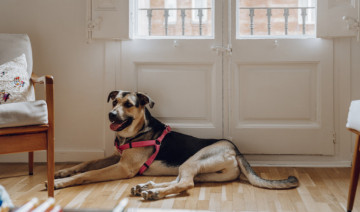
Helping a Dog’s Anxiety in a New Home
Moving to a new home is stressful for everyone, and even pets may feel anxious when their familiar surroundings change. Whether the home is new because of moving from an apartment to a house, relocating to a new city or state, downsizing or upsizing to better meet family needs, or adopting a dog and bringing them home for the first time, there are ways to ease a dog’s anxiety in a new home.
Why Dogs Feel Anxious in a New Home
Many things can make a dog feel anxious in a new home. The scent markers that help a dog navigate and know where everything is are missing or changed, or the dog may smell the old owners or previous pets and not feel comfortable with sharing the space with strangers. All the familiar essentials from the old home – food and water bowls, bedding, toys, potty space, etc. – are in new locations as well, which can create further disorientation. During a move and while the family is getting settled, daily routines may be disrupted, and dogs can also sense their owner’s stress and anxiety from how hectic a move can be.
When a dog is anxious, the animal may develop symptoms of illness such as diarrhea or vomiting, or there may be more frequent potty accidents. Even a normally calm, friendly dog may start barking more or becoming destructive or aggressive. Anxious dogs may also become more needy or clingy, following their owners about or reacting badly to even brief separations. Trembling, hiding, and whining are other common signs of anxiety a dog may exhibit in a new home.
Helping Your Dog Feel Calm and Secure
Fortunately, it can be easy to help a dog feel secure and comfortable in a new home. To help your dog make the transition to a new space…
- Learn the new home’s history.
If the previous owners had pets, it may be wise to deep-clean or steam-clean flooring before moving in, which will help remove odors that could upset your dog. Using enzymatic cleaners will help break down odors more efficiently. Similarly, window coverings should also be thoroughly cleaned, and if there is an outdoor kennel or run, be sure old feces is removed and the area is disinfected.
- Visit the new home with your dog beforehand if possible.
While this is not always practical, if you can take your dog to the new home for visits before the actual move, they will start to get used to the new space. They will begin to recognize new landmarks and scents, and will feel more at ease when they are living there. Even if you can’t go into the house early, walks around the neighborhood or visits to a nearby park where you will go to play after moving can be very helpful.
- Spread scent markers before the move or immediately after.
Your dog will use its nose to learn the layout of its new home, and if there are some familiar scents in the area, the dog will be less stressed. You are the most familiar scent your dog knows, and taking an old shirt and rubbing it on corners, doorframes, or floor areas where the dog will be most often will help spread familiar scents to comfort the animal. Rub your hands over areas or spend time playing on the floor with your dog to spread more scent your pet will recognize.
- Keep your dog away during the actual move.
If possible, use a dog-sitter, boarding facility, or family friends for your dog for a day or two before the move and during the move itself. This will keep your pet out of harm’s way when everything is chaotic with boxes being moved back and forth, doors opening and shutting, and strangers moving in and out – dangerous times when a dog might get hurt or accidentally escape into an unfamiliar place. Once the move is complete and you can set up your dog’s bedding and feeding areas, you can safely bring them to their new home.
- Keep your dog’s familiar routines and accessories intact.
While it can be tempting to toss that old, ragged bed or overly-loved toys to upgrade your dog’s accessories when you move, keeping familiar items around can help calm and reassure your pet in new and scary surroundings. Similarly, keep daily routines such as when to take walks, feeding times, grooming sessions, and other activities as close to the former patterns as possible so your dog can rely on them to feel secure.
- Spend as much time together as possible.
The more you bond with your dog, the stronger your relationship will be and the better the dog will trust you in any new situation or unfamiliar home. Playing together and providing plenty of exercise will help comfort your dog and utilize excess energy that might otherwise be funneled into anxiety. Training sessions and reinforcing commands will also reassure your dog about its place in the family pack, helping it feel more comfortable and secure.
- Update your dog’s paperwork.
As soon as possible after moving, be sure your dog’s identification paperwork is updated. This includes any licensing requirements from a new city, county, or state, as well as updating address records with a veterinarian or providing records to a new vet. Your dog’s microchip information should also be updated, which will be critical if you are separated or your pet becomes lost during the chaos of a move.
Above all, be patient with your dog. It may take a few days or weeks for the animal to become familiar with a new home and feel at ease. Anxiety is common when a dog is moved to a new place, but with thoughtfulness and dedication, you can help your dog adjust to new surroundings and feel right at home, wherever home may be.
